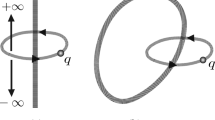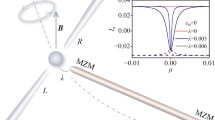Abstract
One of the most promising implications of the phenomenological Ginzburg—Landau (GL) theory of superconductivity is the possible existence of current-carrying metastable states with a negative effective self-inductance. Microscopically this phenomenon can be explained as a result of the depairing mechanism which, when the center-of-mass velocityv s of the Cooper pairs is sufficiently large, can be so strong that a further increase ofv s will lead to a decrease of the total current. Using a one-dimensional formulation of the GL theory we investigate the thermodynamic stability of these states for different external constraints and obtain the result that a negative self-inductance can only be stable if the length of the system in the direction of the current is smaller than a critical value comparable to the GL coherence length λ/κ. It is an experimental fact that states of negative self-inductance are realized in Josephson junctions and other types of superconducting weak links because the dc supercurrent can be a decreasing function of the phase variable φ. The thermodynamic stability theory can therefore explain why weak links have to be short, and it also provides us with a unifying point of view by treating the phase φ and the current as a pair of thermodynamically conjugate variables for arbitrary one-dimensional systems. An important point is the operational phase definition as a thermodynamic parameter that can be controlled by the experimentalist. This requirement is essential for the general validity of the ac Josephson equation and it implies that φ must depend on the magnetic self-inductance of the system. By applying the GL theory to weak links we can delimit the validity of the usual dc Josephson equationI ∝ sin φ and see that deviations from this functional form are most likely to be found in thin-film bridges of the Anderson-Dayem (AD) type. When the currentI is the controlled variable the conjugate phase variable φ will fluctuate and the magnitude of these fluctuations depends strongly on the functional formI(φ). The phase fluctuations for constantI lead to a reduction of the critical current which will be absent when φ is the controlled variable. The observed microwave enhancement of the critical current in AD bridges, the so-called Dayem effect, can be explained as a result of a switch from current control to phase control, and the fluctuation formulae explain why the effect is negligible in structures exhibiting the classical Josephson sine law for the current-phase relation.
Similar content being viewed by others
References
E. B. Hansen,Physica 39, 271 (1968).
J. Bardeen,Rev. Mod. Phys. 34, 667 (1962).
P. Fulde and R. A. Ferrell,Phys. Rev. 131, 2457 (1963).
D. H. Douglass, Jr.,Phys. Rev. 132, 531 (1963).
A. K. Bhatnagar and E. A. Stern,Phys. Rev. Letters 21, 1061 (1968).
O. P. Hansen,Phys. Rev. 181, 671 (1969).
A. Schmid,J. Low Temp. Phys. 1, 13 (1968).
W. A. Little, Symposium on Superconducting Devices, Charlotteville, 1967.
R. Meservey and P. M. Tedrow,J. Appl. Phys. 40, 2028 (1969).
D. E. McCumber,Phys. Rev. 172, 427 (1968).
A. Schmid,Phys. Kondensierten Materie 5, 302 (1966); E. Abrahams and T. Tsuneto,Phys. Rev. 152, 416 (1966); P. Fulde and K. Maki,Phys. Kondensierten Materie 8, 371 (1969).
P. V. Christiansen and H. Smith,Phys. Rev. 171, 445 (1968).
P. V. Christiansen,Solid State Commun. 7, 727 (1969).
L. Kramer,Phys. Rev. 170, 475 (1968).
H. J. Fink and A. G. Presson,Phys. Rev. B1, 1091 (1970).
D. E. McCumber and B. I. Halperin,Phys. Rev. B1, 1054 (1970).
J. S. Langer and V. Ambegaokar,Phys. Rev. 164, 498 (1967).
P. W. Anderson and A. H. Dayem,Phys. Rev. Letters 13, 195 (1964).
A. H. Dayem and J. J. Wiegand,Phys. Rev. 155, 419 (1967).
P. E. Gregers-Hansen, M. T. Levinsen, L. Pedersen and C. J. Sjöström (in press).
A. Baratoff, J. A. Blackburn and B. B. Schwartz,Phys. Rev. Letters 25, 1076 (1970); D. A. Jacobsen,Phys. Rev. 138, 1066 (1965).
P. E. Gregers-Hansen, M. T. Levinsen, L. Pedersen, and C. J. Sjöström, to be published.
A. F. G. Wyatt, inTunneling Phenomena in Solids (Plenum Press, New York, 1969), Chap. 34.
B. D. Josephson,Rev. Mod. Phys. 36, 216 (1964).
A. F. G. Wyatt, V. M. Dmitriev, W. S. Moore, and F. W. Sheard,Phys. Rev. Letters 16, 1166 (1966).
G. M. Eliashberg,Zh. Eksperim. i Teor. Fiz. Pis. Red. 11, 186 (1970).
T. K. Hunt and J. E. Mercereau,Phys. Rev. Letters 18, 551 (1967).
E. Jahnke and F. Emde,Tables of Functions (Dover, New York, 1945).
Author information
Authors and Affiliations
Rights and permissions
About this article
Cite this article
Christiansen, P.V., Hansen, E.B. & Sjöström, C.J. Negative self-inductance in superconducting thin wires and weak links. J Low Temp Phys 4, 349–389 (1971). https://doi.org/10.1007/BF00628738
Received:
Issue Date:
DOI: https://doi.org/10.1007/BF00628738




